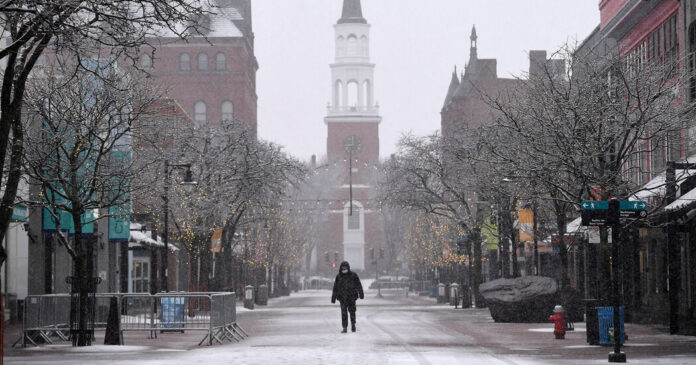A sprawling, late-season winter storm was bringing a mix of precipitation across a wide stretch of the United States on Saturday, knocking out power to thousands and disrupting travel with hazardous conditions, meteorologists said.
About 16 million people from Tennessee up through Maine were under some sort of winter weather alert, while some isolated areas were under a blizzard warning, according to the National Weather Service. The interior Northeast was expected to get the worst of the storm.
“It’s a rather expansive winter storm, but it’s very, very quick moving,” Andrew Orrison, a meteorologist in College Park, Md., at the service’s Weather Prediction Center, said on Saturday. “So it’s one of those deals where the worst impacts are really just going to be for today.”
Heavy snowfall was already affecting the central Appalachians on Saturday morning, Mr. Orrison said, and it would be moving rapidly across the northern mid-Atlantic region and up into the Northeast over the course of the day.
Snow may fall in some places at a rate of one to two inches per hour and may combine with winds of up to 50 miles per hour, leading to “blowing and drifting snow” from the central Appalachians to the Northeast, the Weather Prediction Center warned on Twitter on Saturday morning.
“Severely reduced visibility and white-out conditions will make travel extremely dangerous at times,” the center said.
The center also warned that sharp temperature drops overnight could lead to dangerous conditions on untreated roads and that strong winds on the backside of the storm combined with the heavy wet snow could contribute to power failures and tree damage.
Nearly 80,000 people were without power in Georgia as of Saturday morning, including nearly 38,000 people in the Atlanta metropolitan area, according to Georgia Power.
More than 74,000 people were without power in North Carolina and tens of thousands of others were without power in Alabama, Florida, Pennsylvania, South Carolina and Virginia, according to PowerOutage.us, which aggregates data from utilities across the United States.
The severe weather conditions were also affecting travel on Saturday, with more than 1,000 flights canceled within, into or out of the United States as of Saturday morning, according to FlightAware, a flight tracking service. There were more than 2,800 flights delayed.
Areas across North Texas and southern Oklahoma received a few inches of snow on Friday. Similar snow totals were reported around eastern Tennessee and in portions of Kentucky on Saturday morning.
Dolly Parton’s amusement park, Dollywood, in eastern Tennessee, was scheduled to open to the public for the first time this year on Saturday, but the opening was postponed because of overnight snowfall.
Parts of Kansas received as much as five inches of snow, the Weather Service said. Warnings about the weather prompted Kansas City, Mo., to close its public schools on Friday.
Record low temperatures were likely for much of the Southeast on Sunday.
The Northeast was most likely to get the brunt of snow accumulations, forecasters said. Areas around Albany, N.Y., could receive up to four inches of snow, while areas farther north could receive as much as 12 inches.
In Vermont, seven to 14 inches of snow was forecast for much of the state, and parts of northern Maine could get 12 to 18 inches.
One meteorologist said that it was not unusual to see a late winter storm system in March.
“March is one of those months where there are some years that we see plenty of snow and there are some years we see next to nothing,” Torry Gaucher, a meteorologist with the National Weather Service in Norton, Mass., said on Friday.
“Technically, we’re in meteorological spring,” he added. “Calendar-wise, we have another month before spring really arrives.”
Cities closer to the coast, including New York City and Boston, were expected to receive a mix of rain and snow, with significantly less accumulation. The Boston area could receive at least an inch of snow on Saturday and Sunday morning.
This weekend’s storm follows a pattern of active winter weather throughout much of the South and East Coast this year.
In early January, back-to-back storms created perilous driving conditions in the Mid-Atlantic and the Northeast, including one weather system that stranded hundreds of drivers on Interstate 95 in Virginia for more than 24 hours. The storm trapped truckers, students, families and every stripe of commuter, including Senator Tim Kaine.
In mid-January, another storm slammed the South, killing at least two people and leaving thousands without power before moving north and dropping heavy snow over parts of the Northeast and Canada.
Another January storm swept through the East Coast, prompting thousands of flight cancellations and prompting the governors of New York and New Jersey to declare states of emergency. That storm dropped more than 30 inches of snow in parts of Massachusetts.
In early February, another storm slammed parts of Texas with snow and sleet, disrupting travel and power. Gov. Greg Abbott called it “one of the most significant icing events that we’ve had in the state of Texas in at least several decades.”
Johnny Diaz contributed reporting.










